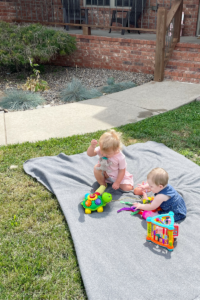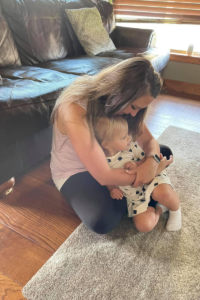Let me preface this post by telling you a little bit about myself and my children so that you have a little bit of context. I was a 4th-grade teacher for six years and also have a master’s degree in education. I have always had a deep interest in human behavior and I was on the behavioral team at the school I worked at where we met to discuss behaviors that were being seen in the classrooms. We created strategies for students that needed extra support and worked with their teachers to implement these ideas. I was able to attend the Midwest Symposium for Leadership in Behavior Disorders and learned about complex trauma in childhood, how to build positive student behavior, and much more.
I have a two-year-old and a 9-month-old and I can confidently admit that I am new to all of this! However, through parenting, my background in education, and my ongoing study into how to help my children be the best they can be I feel I can possibly give some value to others. I am a stay-at-home parent and have quite a bit of control of our schedule, home atmosphere, and my children are used to me as a caregiver and disciplinarian. I recognize that this routine and consistency help, and that not all families will have this. I still believe the following tips can be helpful for anyone!

Another disclaimer: toddler meltdowns are normal and are not the determining factor of a good/bad child or a good/bad parent. They cannot be eradicated altogether because developmentally, young children don’t know how else to express their anger, dislike, sadness, frustration, etc.
Basically, I could make this post 95% shorter by telling you to have plenty of snacks on hand, go outside once a day, and get earplugs for the hard days. But, here are some other, more meaningful tips too.
Prioritize Naps and Implement Rest Times
The name of this tip is a bit self-explanatory so I won’t comment on it much. My daughters both take a 2.5-3 hour nap during the afternoon. Even if I notice that my two-year-old isn’t giving me the normal “sleepy cues”, I still lay her down for a nap because otherwise, she will start to become harder to parent. When we have traveled and they miss a nap or go to sleep at a later time, it’s always evident that night or even into the next day that they were off of their routine.
My two-year-old doesn’t take two naps anymore, but she still needs some time in the late afternoon that has reduced stimulation because I find she begins to get cranky otherwise. This may mean we lay on the couch and read a book with no TV on and no lights on (we have amazing huge windows in our living room that bring in wonderful light!), or we sit on the deck in the sunshine with a snack and talk with the dog. But, this little rest time helps to recharge her for the last couple of hours before bed.

Give Children a “Heads Up”
A lot of things are amplified in a child’s mind. Having to go to bed after playing with their toys is probably the equivalent of an adult at a theme park riding rides and then suddenly being thrown onto their bed in a dark room at Disney World.
In my classroom, I was always giving my students a “heads up”. You have 10 more minutes to be on the computer game. We need to start cleaning up in 5 minutes. Let’s start a countdown for Christmas Break. If we get things cleaned up in 2 minutes, we can go outside early.
I began doing this with my oldest daughter very early, even before she was able to understand or communicate back. I let her know when it’s almost nap time. (“After lunch, we’re going to go lay down for a nap.”). I let her know when we’re 30, 20, 10 minutes away from leaving the house (“We’re going to go bye-bye to the store soon. What shoes do you want to wear?”). I tell her that after dinner, we’re going to get ready for bed (“Let’s go get your pajamas on! We’re going to go to bed soon.”).
Giving this heads up has allowed me to communicate with my toddler that something is about to happen, play is going to end, bath time is almost over, bedtime is drawing near, etc. It’s these little reminders that are helping her to slowly begin preparing herself for a change. She may still not like it but at least she saw it coming!
Have Desirable Replacement Items or Activities Available
This is kind of part two to my number two tip. If you know your child throws a fit when you take something away or remove them from a space they love, replace it with something else they enjoy. Here are some examples:
My daughter LOVES going outside to walk in our yard. Saying hi to the dogs, jumping on the trampoline, throwing rocks into our little pond, swinging. She could do it for hours. So, I’ve made it to where we go outside and then always come inside for a snack. Replacing something she loves with something else she loves. One day I made a little chant to get her ready to come inside (after giving her the “heads up”). Together, we chanted, “Inside! Wash! Snacks!”. Now, she’ll start chanting that after I tell her when we need to go inside when otherwise I’d have to carry her in, kicking and screaming.

Bedtime can be a struggle some nights, but it’s because the fun should never have to end! My daughter absolutely loves books so I got some of these mini flashlights. On hard nights, I will let her choose a book to bring into bed with her and she gets a flashlight to “read” in bed. They don’t put off a lot of light and she has to be pushing the button to keep it on. So, inevitably, she falls asleep in a couple of minutes and the light goes off automatically.
My daughter doesn’t love brushing her teeth, but she loves to mess with the light switch. So, I sit her on the counter and she plays with the light switch while I quickly brush her teeth. The flashlight also came in handy for this, too, when one day we turned out all the lights and used the flashlight to see her teeth. It was a huge hit!
Make a list of things your child loves – activities and tangible items. When one thing needs to be taken away/ended and it would normally cause a tantrum, what else from the list can you exchange it with?
Fill Up Love Tanks and Maintain Connection
Just because you’re their parent doesn’t give you an easy access pass to be the hero in your child’s life.
You still have to work for that title and earn it. In order for them to behave desirably in your eyes, you have to model it and give one of the most valuable, non-renewable resources you have: your TIME.
You’ll either spend time when they’re little to be intentional in teaching the most meaningful life lessons, OR you’ll spend time when they’re older trying to un-do the behaviors you dislike.
Either way, you’re spending the time. Personally, I’d rather use that time to be proactive.

Acknowledge They Are Human, Too
We’re adults and we know how life works. We know we have things to do that we don’t want to do and we have the maturity and understanding to handle that.
Young children just don’t. They want to show independence. They have zero to little patience. They have hard, stressful days even if it seems silly to be “stressed” about a baby doll missing her binky or a beloved bracelet that broke even though you have one that looks the exact same to replace it with. They don’t understand why you’re dropping them off at a strange place and leaving them with strangers. They can’t be reasoned with when it’s their nap time but you want to go out to dinner and have them sit quietly.
Give them grace, and give yourself grace for trying to learn how to parent these special people.
These small adjustments are not meant to cater to our kids. Some might say this is a way to spoil a child, not let them learn the hard way, they need to get used to not having things their way. Ultimately, God is using parents as the potters of the clay he’s handed us. We’re all just doing the best we can, right?
